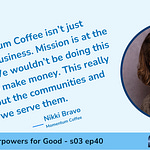Yesterday (Nov 5, 2025), Jen Risley—editor of the Main Street Journal—and I hosted our monthly livestream conversation. Each month, we compare notes on what’s moving in community capital and how the Main Street investing movement intersects with the impact-crowdfunding work we do here. Yesterday’s talk was packed; here are the big threads and why they matter—especially if you’re joining us from the MSJ community.
The plumbing we’re (finally) seeing.
Jen led with a piece that captured my imagination: Michael Shuman’s interview with DW Ferrell about the “plumbing of local finance.” DW has built something deceptively simple and potentially transformative: “a ledger that connects a group of community-aligned funds.” If you’ve ever asked, “Where’s the local stock exchange?”—this is one credible attempt to answer it. Even better, DW’s on-ramp is intentionally low: “It starts at 50 bucks,” which means regular people can test, learn, and participate without having to be whales.
For readers new to our corner of finance: when we say regulated investment crowdfunding, we mean a U.S. framework that lets everyday people invest small amounts in startups and local businesses through SEC-regulated online portals (websites that host these offerings). It’s not donation crowdfunding; you’re buying a stake (equity or debt). One problem we’re always trying to solve is how these small, early investments connect into a broader system so communities can keep capital recycling locally. A ledger that links mission-aligned funds is one promising piece of that system.
Public banks and the NYC thought experiment.
We also kicked around a timely idea: could a public bank in New York City help? The U.S. has one durable precedent in North Dakota. We talked about how a city- or state-owned bank might partner with local lenders instead of competing with them, and we acknowledged the regulatory headwinds that have slowed efforts in places like California. Still, the upside is huge: “If you could have New York City pull this off… what city wouldn’t try to duplicate that?”
A public bank is simply a bank owned by the public (city/state), chartered to serve public priorities—think financing local infrastructure, affordable housing, small business lending—often in partnership with community banks and credit unions. In our world, that public bank could pair with community equity raised via crowdfunding, creating a capital stack that makes more Main Street projects financeable.
Why the pieces fit “hand in glove.”
That pairing is the heart of what excites me: if a bank focuses on lending to local businesses and the crowd (neighbors, customers, fans) provides some equity, the bank’s risk drops and more loans pencil out. As I put it on the livestream, “It’s the perfect complement. Hand in glove, they fit.”
Raising communities, not just capital.
Jen pulled a line from my recap of the Crowdfunding Professional Association summit that sums up the movement’s soul: regulated investment crowdfunding “isn’t just about raising capital. It’s about raising people, raising communities and raising possibilities.” That’s not rhetoric for us—it’s the metric. The capital is a means; the measure is whether people, places, and small businesses are stronger afterward.
What “liquidity” can look like.
One question MSJ readers often ask is: How do I ever get my money back? There isn’t one answer, but I shared a personal example: I invested in Aptera years ago; those shares now trade on a public exchange. That doesn’t make every crowdfund investment liquid, but it illustrates a path: early, community-backed ventures can mature into publicly tradable companies, creating, in my words, “a clear path to liquidity.”
Bridging purpose-driven networks.
We also talked about Rotary. I’d just aired my conversation with Rotary International President Francesco Arezzo. Rotarians are relentlessly local and globally minded—cleaning parks on Saturday and fighting disease overseas the next. Many still haven’t encountered investment crowdfunding, but I’m convinced they’ll recognize the values-fit when they do.
For MSJ readers new to Superpowers for Good: that’s our mission—telling the stories of founders and communities raising patient, values-aligned capital and stitching together the ecosystem so more people can participate.
Two communities, one Main Street.
Jen and I wrapped with mutual invitations: if you’re part of the Super Crowd and you’re not reading the Main Street Journal yet, you’ll find indispensable reporting on buy-local strategies, local investing, and the policies that make it all work. As I said on the livestream, consider subscribing—it’s a small monthly investment for outsized learning. And to MSJ readers discovering us: you’re welcome here. We publish daily interviews, weekly deep dives, and hands-on guidance for founders and investors who want to fuel their hometown’s economy.
What’s next.
I plan to invite DW Ferrell on the show to unpack that ledger concept further—and, yes, I’m putting my own “50 bucks” to work to learn by doing. If you joined us live yesterday (Nov 5), thank you. If not, watch the replay above. Either way, pull up a chair. The plumbing of local finance is getting real—and we get to help lay the pipes.













